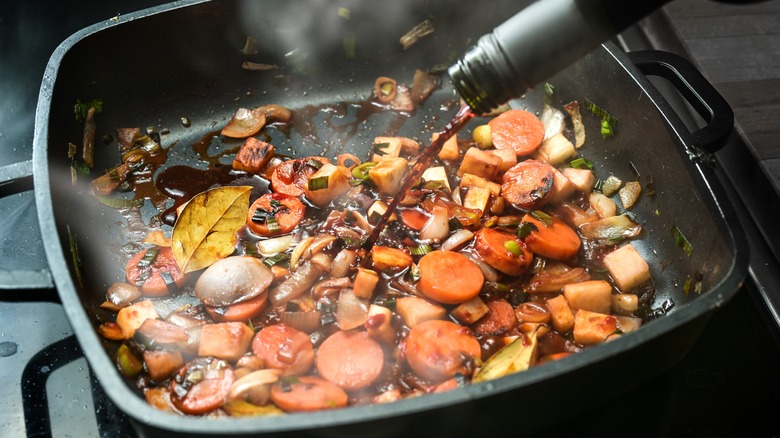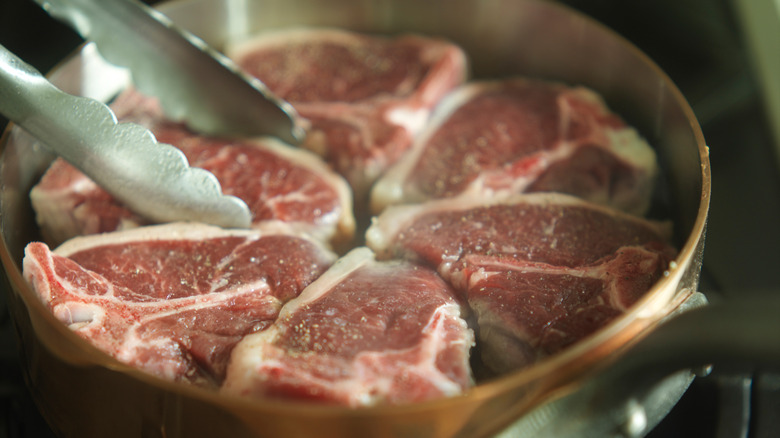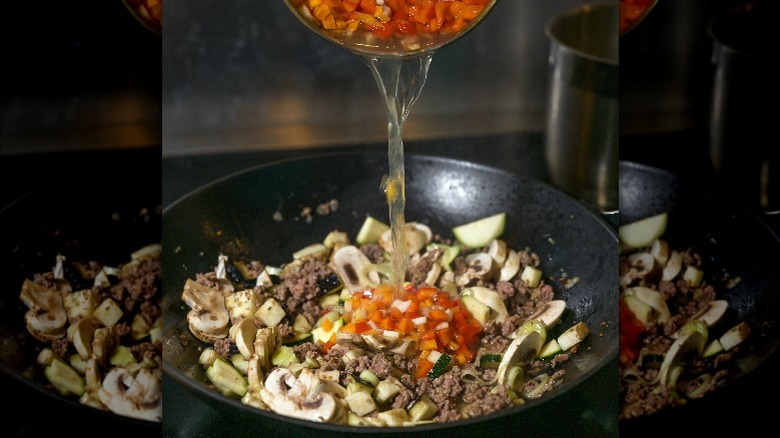What Everyone Should Know To Become A Deglazing Pro
If you're an avid watcher of cooking shows, "deglazing" should sound familiar. Still, that doesn't necessarily mean you know what it is. It sounds like a technique requiring formal training or at least lots of experience in the kitchen, but it's pretty simple. All it takes is cooking your favorite proteins, vegetables, and spices in a pan, and then you'll be deglazing like a pro in no time.
Deglazing simply means "to add liquid to the cooking juices and small pieces of food in a pan in which something has been cooked, in order to make a sauce." French terminology has a name for those bits of food stuck to the pan: "fond," which translates to "base" in English. This is important to remember next time you almost forget to splash liquid onto those little nuggets before scraping them up. Those morsels are necessary for a terrific sauce since they pack in a bunch of flavors. So, you should be fond of your base.
"A lot of people think it's only worth deglazing if you're making a pan sauce," as Adrienne Cheatham – chef at the Institute of Culinary Education — told Yahoo, "but even if you're just searing chicken, it's worth deglazing, because otherwise, you're leaving so much flavor behind."
How to find a world of flavor at the bottom of your pan
After cooking proteins or vegetables, preferably in cast-iron cookware or a stainless steel pan, you want to remove and set that food aside. Then, start looking for the caramelized pieces left over and ensure the remaining medley isn't burnt. Giving it a little taste might not be a bad idea; after all, burnt pieces will likely result in a ruined sauce. Another issue is the remaining oil or grease; most of it should be removed, but try to leave some in for flavor.
Once that's done, slowly pour in your liquid (more on that later) and then rake the bottom of the pan with a flat-edged kitchen utensil. This will guarantee a better chance of gathering up all the holdouts clinging to the metal. Importantly, you'll want to use a cold or room-temp fluid; not only is the resulting sizzle half the fun, particularly when impressing dinner guests, but it also aids the process, because you'll want to "reduce" what remains by half.
The best liquids to use when deglazing
Water isn't the best for deglazing. While it gets the job done, you're not adding anything, instead diluting the flavors left in the pan. And there are some liquids you might want to avoid completely. For instance, you should reconsider using dairy to deglaze a pan; milk and cream can be added later, specifically when creating a cream sauce, but they tend to curdle when employed at the deglazing stage.
That said, a wide array of delicious fluids can be used. For example, some classic options include stock, broth, juice, and vinegar. Aromatic liquids like Worcestershire sauce, as well as seasonings, should also be considered. Whatever you choose, match it appropriately to the proteins or vegetables utilized.
Additionally, a person can't go wrong here with alcohol. Whether it's spirits, wine, beer, or cider — as long as the additive complements the other components — the sky is more or less the limit. After all, the whole point of deglazing is to create a nuanced yet complex profile to use as a base for your sauce.
Ultimately, there should be no issue if one remains mindful of the ingredients and their interactions. More importantly, you now have a creative avenue to explore when making sauces, gravies, and au jus that will complete your tasty steak, chicken, pan-seared vegetables, or fish you've been working hard on.


